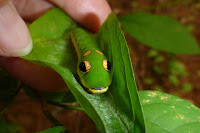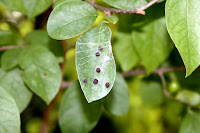Spicebush Swallowtail Caterpillars
 These little Spicebush Swallowtail Caterpillars are only able to eat and live on Spicebush shrubs so when Marilyn Stewart told us about them we bought a couple of the shrubs.
These little Spicebush Swallowtail Caterpillars are only able to eat and live on Spicebush shrubs so when Marilyn Stewart told us about them we bought a couple of the shrubs.During the drought years, most butterflies went past our region of the country, heading for more hospitable places. But this year we are having a baby boom all over our little piece of earth.
When looking for the first little caterpillars you'll see leaves chewed and folded over like the one on the left.
When the egg first hatches the caterpillar (larva) eats the contents of the egg for nutrients, then begins to chew the leaves. Their bodies emit a sticky substance that helps them in their work.
So here's a tiny caterpillar on the right with my soiled garden hand for size comparison. The leaf was folded over and I opened it so you could see the little guy inside.
Butterfly poo is called frass. I suppose just to avoid calling it poo. Notice the size of the butterfly caterpillar and its frass.
Also, notice the white-ish substance along the midrib of the leaf. That helps it stay where it needs to be and helps seal the leaf closed to protect it from predators.
The next photo is frass from a full size caterpillar which is no longer visible to us because it has moved on to form its chrysallis.
The photo of one this size is at the top of the post.
In all the years that we have been growing Spicebush Swallowtail Caterpillars we have spotted only a few of the cocoon/chrysallis. And those were attached to the fence of the vegetable garden nearby.
 |
| photo from Dallas Butterflies |
The links below the next two photos will take you to Dallas Butterflies, Gardens With Wings, and Shady Oak Farm where you can find more great information about these beautiful garden pets.
 |
| photo from Shady Oak Farm |
 |
| Spicebush Swallowtail Butterfly range photo from Gardens With Wings |
The Spicebush Swallowtail native range is centered on the east and southeastern U.S.
Of course, they wander outside of their native range. But you can only get the babies if you plant a Spicebush! Its Latin name is Lindera Benzoin.
The website GardenList has a good list of places you can order native plants though a couple of my favorites aren't on that list. Start locally. Contact the native plant society for your state and ask where to buy locally grown plants. They will thrive best in your soil and weather conditions. More natives = more habitat = healthier garden = less work for you.







Comments